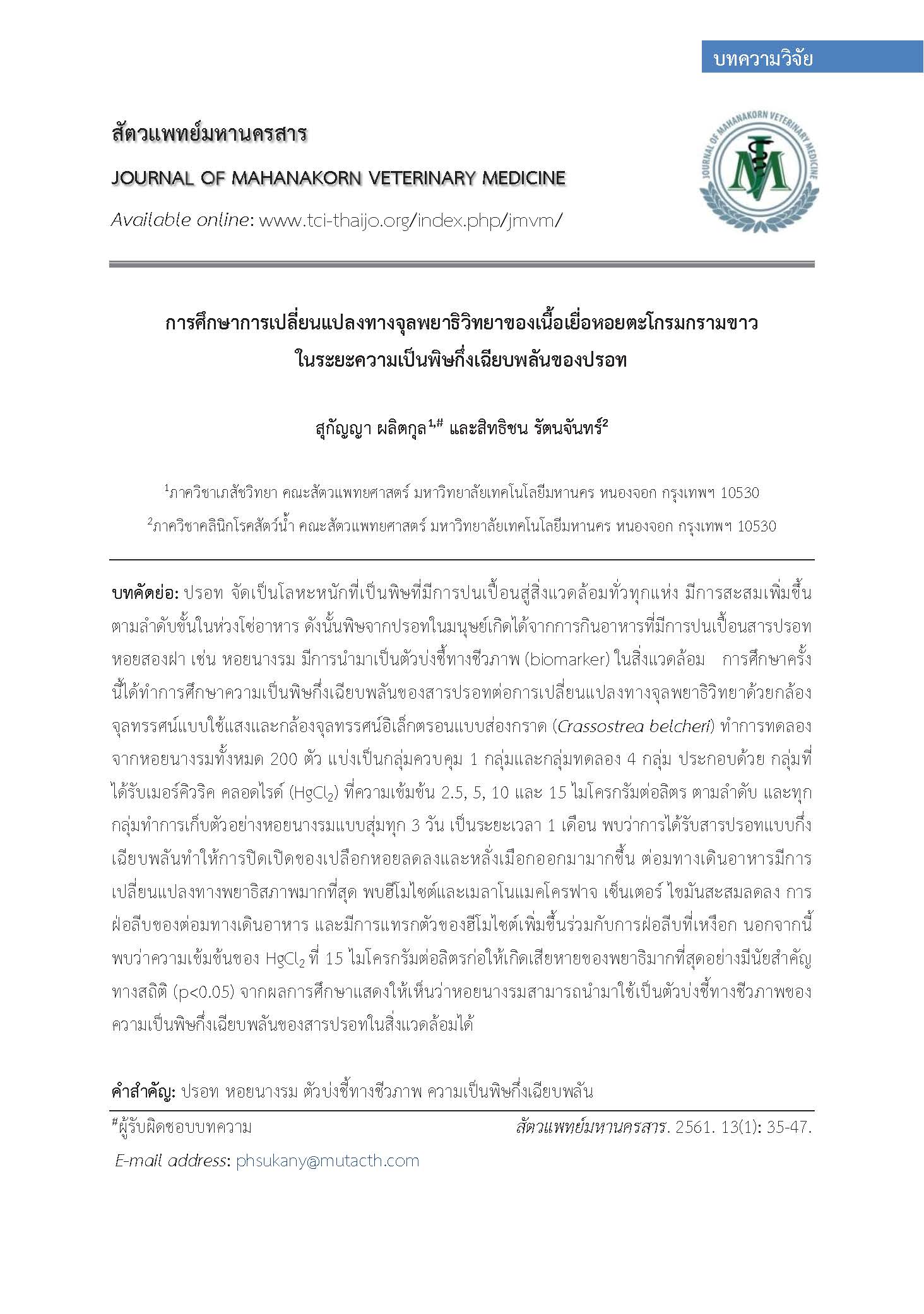Histopathological Changes on Oyster Crassostrea belcheri Exposed to Subacute Mercury Toxicity
Main Article Content
Abstract
Mercury (Hg) is a toxic heavy metal that is ubiquitous environmental contaminants. It leads to biomagnification to food chain. Therefore, mercury poisoning in human can be caused by consuming mercury contaminating diets. Bivalve shellfish, such as oysters, focus on the biomarker for environmental monitoring. In this study, we examine subacute toxicity of mercury to histopathological changes by using light microscope and scanning electron microscope in oyster (Crassostrea belcheri). Two hundred oysters were divided into one control group and four experimental groups. Each experimental group was treated mercuric chloride (HgCl2) at different concentrations including 2.5, 5, 10 and 15 µg/l respectively. Each group was randomly sampling every three days for one month. The results found that subacute mercury exposure diminished the occurrence of shell gaping as well as increased mucus secretion. Digestive gland was significant pathological damages. Histopathology showed hemocytes and melanomacrophage centers infiltration, decreasing lipid storage and digestive gland atrophy. Increasing of hemocytes infiltration and gill atrophy were also found. In addition, the concentration of HgCl2-exposure at 15 µg/l affected on the most histopathological changes (p<0.05). The present result indicated that the oysters can be used as the biomarker of subacute toxicity of mercury in the environment.
Article Details
References
2. ดาราวดี ใจคุ้มเกล้า. 2546. การสะสมของสารปรอทในหอยนางรมและหอยแมลงภู่จากบริเวณอ่าวไทยและทะเลอันดามัน. วิทยานิพนธ์ปริญญาวิทยาศาสตร์มหาบัณฑิต, สาขาวิชาวิทยาศาสตร์สิ่งแวดล้อม, มหาวิทยาลัยบูรพา. 110 หน้า.
3. มณีย์ กรรณรงค์. 2547. การเจริญเติบโต การปนเปื้อนของแบคทีเรียในหอยตะโกรมกรามขาว, หอยตะโกรมกรามดำและหอยนางรมปากจีบ บริเวณแหล่งเลี้ยงอ่าวบ้านดอน จังหวัดสุราษฎร์ธานี. ผลงานวิชาการการสัมมนาทางวิชาการครั้งที่ 44 ศูนย์วิจัยและพัฒนาประมงชายฝั่งนครศรีธรรมราช. สิงหาคม – กันยายน 2547: 60-74.
4. ศิริวรรณ ลาภทับทิมทอง. 2544. การสะสมโลหะหนักบางชนิดในหอยเศรษฐกิจ บริเวณชายฝั่งทะเลของอ่าวไทยและทะเลอันดามัน. วิทยานิพนธ์ปริญญาวิทยาศาสตร์มหาบัณฑิต, สาขาวิชาวิทยาศาสตร์สิ่งแวดล้อม, มหาวิทยาลัยบูรพา. 130 หน้า.
5. ศิริลักษณ์ วงษ์วิจิตรสุข. 2552. Biomarker กับบทบาทที่สำคัญในงานอาชีวอนามัยและความปลอดภัย. วารสาร มฉก.วิชาการ. 12(24): 89-99.
6. สำนักงานเศรษฐกิจการเกษตร. 2560. (สืบค้นข้อมูลเมื่อ 5 เมษายน 2561). สถิติการเกษตรของประเทศไทย. เข้าถึงได้จาก: https://www. oae.go.th/download/download_journal/2560/yearbook59.pdf.
7. Azevedo, B.F., Furieri, L.B., Pecanha, F.M., Wiggers, G.A., Vassallo, P.F., Simoes, M.R., Fiorim, J., de Batista, P.R., Fioresi, M., Rossoni, L., Stefanon, I., Alonso, M.J., Salaices, M. and Vassallo, D.V. 2012. Toxic Effects of mercury on the cardiovascular and central nervous systems. J. Biomed. Biotechnol. 2012: 1-11.
8. Bigas, M., Durfort, M. and Poquet, M. 2001. Cytological effects of experimental exposure to Hg on the gill epithelium of the European flat oyster Ostrea edulis: ultrastructural and quantitative changes related to bioaccumulation. Tissue & Cell. 33(2): 178-188.
9. Devi, V.U. 1996. Changes in oxygen consumption and Biochemical composition of the Marine Fouling Dreissinid bivalve Mytilopsis sallei (Recluz) exposed to Mercury. Ecotoxicol. Environ. Saf. 33(2): 168-174.
10. Di Giulio, R.T. and Newman, M.C. 2013. Ecotoxicology. In: Casarett and Doull’s Toxicology. 8th ed. Klassen, C.D. (ed). McGraw-Hill Education. New York. 1473.
11. Flora, S.J.S. 2014. Metals. In: Biomarkers in toxicology. Gupta, R.C. (ed.) Academic Press. MA. 1088 p.
12. Gosling, E. 2015. Marine Bivalve Molluscs. 2nd ed. Wiley Blackwell. NJ. 537 p.
13. Hodgson, E., Roe, R.M., Mailman, R.B. and Chambers, J.E. 2015. Dictionary of Toxicology. 3rd ed. Elsevier. CA. 372 p.
14. Howard, D.W., Lewis, E.J., Keller, B.J. and Smith, C.S. 2004. Histological techniques for marine bivalve mollusks and crustaceans. 2nd ed. NOAA Technical Memorandum NOS NCCOS 5. Oxford. 218 p.
15. Kaplan, B.L.F., Sulentic, C.E.W., Holsapple, M.P. and Kaminski, N.E. 2013. Toxic responses of the immune system. In: Casarett and Doull’s Toxicology. 8th ed. Klassen, C.D. (ed). McGraw-Hill Education. New York. 1473.
16. Kadar, E., Costa, V., Santos, R.S. and Lopes, H., 2005. Behavioural response to the bioavailability of inorganic mercury in the hydrothermal mussel Bathymodiolus azoricus. J. Exp. Biol. 208: 505-513.
17. Kumar, B, Smita, K. and Flores, L.C. 2017. Plant mediated detoxification of mercury and lead. Arab. J. Chem. 10: S2335-S2342.
18. Marchi, B., Burlando, B., Moore, M.N. and Viarengo, A. 2004. Mercury- and copper-induced lysosomal membrane destabilisation depends on [Ca2+]i dependent phospholipase A2 activation. Aquat. Toxicol. 66(2): 197–204.
19. Mason, R.P., Choi, A.L., Fitzgerald, W.F., Hammerschmidt, C.R., Lamborg, C.H., Soerensen, A.L. and Sunderland, E.M. 2012. Mercury biogeochemical cycling in the ocean and policy implications. Environ. Res. 119: 101-117.
20. Moore, M.N., 1991. Lysosomal changes in the response of molluscan hepatopancreatic cells to extracellular signals. Histochem. J. 23(10): 495–500.
21. Nikinmaa, M. 2014. Introduction: What is Aquatic Toxicology?. In: An introduction to aquatic toxicology. 1st ed. Academic Press. MA. 236 p.
22. Ramakritinan, C.M., Chandurvelan, R. and Kumaraguru, A.K. 2012. Acute Toxicity of Metals: Cu, Pb, Cd, Hg and Zn on Marine Molluscs, Cerithedia cingulate G., and Modiolus philippinarum H. Indian J. Geomarine Sci. 41(2): 141-145.
23. Sheir, S.K., Handy, R.D. and Galloway, T.S. 2010. Tissue injury and cellular immune responses to mercuric chloride exposure in the common mussel Mytilus edulis: Modulation by lipopolysaccharide. Ecotoxicol. Environ. Saf. 73(6): 1338-1344.
24. Tall, B.D. and Nauman, R.K. 1981. Scanning electron microscopy of Cristispira species in Chesapeake Bay oysters. Appl. Environ. Microbiol. 42(2): 336-343.
25. Viarengo, A., Marro, A., Marchi, B., Burlando, B., 2000. Single and combined effects of heavy metals and hormones on lysosomes of haemolymph cells from the mussel Mytilus galloprovincialis. Mar. Biol. 137(5-6): 907–912.


